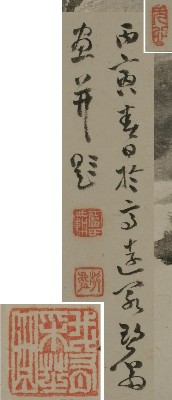Nanga
LandscapeSigned: oite tei .. ... Hekiô gaheidai
Seals: Fukuda seikô, Seishô, Mushin (top) & Gayû saishi (bottom)
Technique: sumi on paper 135,5 x 30,7
Date: Spring 1926
Mounting: green azue damask 204 x 42
Box: signed
The poem reads:
From the clouds I hear the crowing rooster,
along the roads see dropped bundles of firewood.
These remote walls are cut off from the world of men;
herein reside citizens of high antiquity!
The sun rises: we plow the hidden valley;
the sun sets: we lie on mats of grass.
We draw water only from fresh mountain springs
and associate with the whitest clouds.
Could this not be the realm of Peach Blossom Spring?
I've come here and gotten confused about the ford!
No need to bother staying on and on:
for now, I am a refugee from Qin. (trans. Jonathan Chaves)
Addiss and Chaves, Old Taoist, The life, art and poetry of Kodôjin (1865-1944), New York 2000
This poem is based on the famous story by Tao Yuanming (365-427), Taohuayuan ji (In the Peach Blossom Valley).
Kodôjin was a self-taught literati painter, an individualist and an eccentric who did not belong to any art circle. Although not recognized by art critics he was successful with a small group of collectors. Some of these supporters were very important and rich. After he met the great haiku poet Masaoka Shiki (1867-1902) in 1889, he became his follower. He is therefore also well known as the haiku poet Fukuda Haritsu.
Reference:
Addiss 2000
Berry & Morioka ‘99 p. 216-217 (# 61-63)
Berry & Morioka ‘08 p. 256-57 (# 49-50)
Berry '01 pp.192-193
Gitter-Yelen ’02 p. 250-251
Price: SOLD

